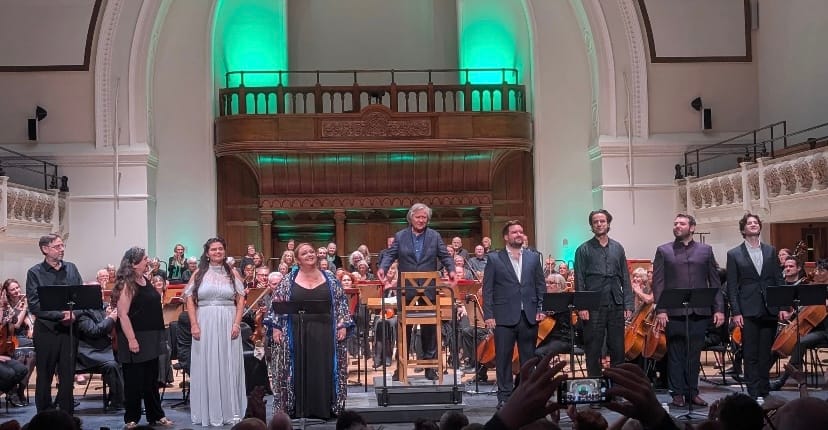
Bellini La strraniera (concert performance) Cast; Chorus and Orchestra of Chelsea Opera Group /. Stephen Barlow (conductor) Cadogan Hall, London, 01.06.2025
Cast:
Alaide (La straniera) – Heena Dix
Valdeburgo – Dan D’Souza
Isoletta – Geogia Mae Bishop
The Lord of Montolno – Kevin Hollnds
Osbirgo – Will Diggle
Arturo – Thomas Elswin
Prior to the Knights Hospitalier – Thomas D. Hopkinson
A very rare outing here for Bellini’s two-act opera La straniera (The Foreigner). Opera afficionados will probably know this from Renata Scotto’s recording from 1970 with Ettore Gracis at the helm (worth putting up with the scrappy orchestra for Scoto), or perhaps David Parry’s Chandos version with Patricia Cioffi). Good to hear it live, though, with a cast dominated by the Alaide of soprano Helena Dix.
La straniera follows on from the success of Bellini’s Il pirata, premered at La Scala in 1827. Taking its plot from Prévot’s L’Étrangère, La straniera was premiered in early 1829. It has had a chequered history. After an initial flush of success, it rather disappeared, revived in 1935 at Scala wit Gina Cigna; it was that Scotto recording that really helped, with Caballé taking up the role in New York in 1969.
The setting is medieval Brittany. Alaide is a mysterious woman who lives in exile; Arturo (tenor) falls in love with her. He is a nobleman who is inconveniently engaged to Isoletta (mezzo), daughter of the Count of Montolino (bass). But Alaide rejects Artuto; wors, Artuo mistakes laide’s brother, Valdeburgo, for her lover (this ai’t Wagner), wounding Valdeburgo in th pocess (who flls into a lake)she does however save him in a murder accusation. She is, in fact, Queen Agnes of France, living in hiding for her own safety. Arturo commits suicide because of her rejection, and Alide returns to her royal life.
Helena Dix’s assumption of the title role was magnificent, and utterly tireless, effortlessly riding the combined forces of orchestra, chorus and fellow soloists. But she could provide real tenderness, too, her aria (here are remarkably few solo arias in this opera) “Col sorriso d’innocenza” a highlight (a mention for principal flute Ben Pateman is due here, too). This is one of Bellini’s sublime melodies, and needs exactly the long-line legato Dix found. And how Dix could convey her character’s pain, absolutely piercing at the end of the first act
Dan D’Souza’s Valdeburgo was generally strong, but could berather too literal in the early stages of the opera. As the wronged Isoletta, Georgia Mae Bishop was a force to be reckoned with herself; the two spend a fair amount of the early part of act I in duet, and very effectively so, while her act II aria, “Ne alcun itorna … O cruda” was both involving and touching. It is worth remembering that Bishop made a fine Giovanna Rigoletto at Opera Holland Park in 2023 (review). But it was the heroic tenor of Thomas Elwin that convinced . This is a tenor part that descends into the baritone register fairly regularly, and Elwin has what it takes.
Kevin Hollands was a finely honed Montolino. The Prior of the Knights Hospitalier has to wait until the second act to sing, but when he did (Thomas D. Hopkinson) it was with real authority. I was rather less taken by Will Diggle’s Osburgo (Montolino’s henchman). Individuals aside, Bellini’s writing revels in vocal combinations, including a fine section towards the opera’s close. Bellini’s writing is masterful throughout, in fact. Perhaps the opera’s downfall is its relative lack of solo arias, and those expecting a continuous outflow of florid lines might be disappointed. Against this is a fine handling of the Gothic story. Bellini’s fingerprints are all over the score; a most worthwhile endeavour (as always, it seems from COG)
The conducting was somewhat workady generally; the piece needs verve to make it work. It also needs the darker passages for the strings towards the end of act one (prior to Alaide’s “Ah, non partir”) to make their mark, while the chorus was variable The orchestra was notable for its individua or sectional contributions – horns in the act 1 hunt scene, for example, less for its balancing in tuttis.
Performatively, a mixed evening, then, but La straniera emerges as a fascinating piece.









